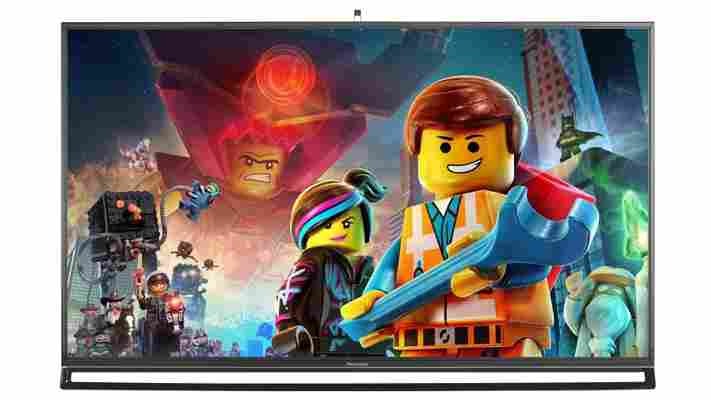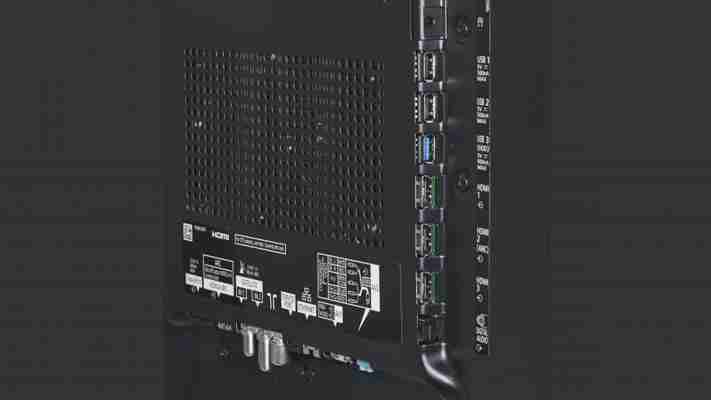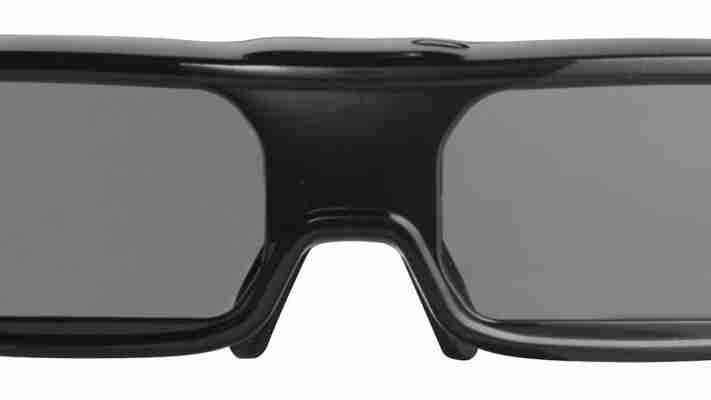Panasonic TX-50AX802B review
When it launched the Panasonic TX-50AX802B Ultra HD TV was a little disappointing, as it didn't support 4K Netflix. Fortunately, the job of fixing this issue proved easier than Panasonic initially thought, and the TV has now been updated to support it. That's fanastic news, as image and quality wise, it's one of the best TVs that we've ever tested. It's really coming into its own now, with BT Ultra HD TV also available.
For this review we tested the 50in model in the AX802B range, but it's also available in 58in (TX-58AX802B) and 65in (TX-65AX802B) screen sizes. All models have identical specifications except for their dimensions and power usage. We're confident that image quality will be practically identical across the range.
Image quality
With these two additional factors in mind, the AX802 series is now one of the best 4K TVs available today. The screen's picture quality is superb, and our colour calibrator showed the AX802 was displaying a near-perfect 99.4 per cent of the sRGB colour gamut on its default colour profile. This is outstanding, as other Ultra HD TVs we've tested, such as the Samsung UE65HU8500 , only showed 92.6 per cent at its default settings. The AX802's colour coverage, on the other hand, was well spread across all the primary colour groups, leaving little need to calibrate the TV to get a better picture.
The TV's low black level of 0.04cd/m2 also meant that blacks were deep and dark with no signs of backlight bleeding. Brightness was a little dim at 143.75cd/m2, but this is easily rectified using the TV's backlight and brightness settings. Contrast was also excellent, measuring 3,309:1. This is just behind the Samsung HU8500's score of 3,808:1, which is supposed to produce better contrast than other TVs because of its curved screen.
As a result, we stuck with the AX802's Normal picture mode throughout our testing, but you can also choose from Cinema, THX Cinema, THX Bright Room, True Cinema, Custom, Professional 1 and 2 and Dynamic, all of which can be customised to your liking.

We found Cinema a little too yellow for our tastes, while both THX modes looked milky. The THX modes also disabled the TV's 16:9 overscan option, which meant you missed a bit of the image round the edges. Dynamic was by far the brightest and most vibrant mode, but also the most unnatural-looking. The two Professional modes, on the other hand, offered a more modest boost in brightness while Custom and True Cinema were more neutral in colour temperature.
Picture settings are extensive and include contrast, colour, tint, sharpness, and colour temperature options. There’s also a letterbox dimmer, an adaptive backlight control and ambient sensor that adjust the brightness to suit your room's lighting conditions, Vivid Colour to enhance vibrancy, Colour Remaster, which lets the TV use an expanded colour gamut without tinkering about with the advanced settings menu, Brilliance Enhancer to heighten contrast, as well as the usual noise reduction and MPEG remaster settings. Be aware, though, that the advanced picture settings (contrast control, white balance, colour management and gamma options) aren't available on Normal, Dynamic or the THX modes.
The 24p Film Smooth mode is available on all picture modes, and it’s Panasonic’s version of frame interpolation. It’s set to Minimum by default, and we found this level more than enough to help smooth some slightly jerky camera movements in our Star Trek test footage. Medium and Max were a little strong for our liking and both showed signs of ghosting.
Naturally, Ultra HD content looked great. We could play Ultra HD video files stored on a USB flash drive without any lag or buffering problems, but we were more impressed with the AX802's upscaling technology. Blu-ray video didn’t look overly smooth or airbrushed, which is something we’ve seen on other Ultra HD TVs, and Star Trek’s famed film grain effect looked sharp and crisp. Similarly, the jungles of Pandora in Avatar were bristling with detail, so your current film collection should still look good on the AX802.
HD TV channels were also surprisingly well-defined. We saw a very small amount of blocking and noise around text on the BBC News HD channel, but on the whole there was still a lot of fine detail present across all channels with very little evidence of mass smoothing. Naturally, standard definition channels were a lot worse, and the noise reduction and MPEG remaster settings did very little to help eradicate the extensive amount of noise and number of artefacts onscreen. Nevertheless, we'd say that Panasonic’s upscaling technology is by far one of the best we’ve seen, and certainly much more pleasant that of Samsung’s HU8500.

TV
One benefit of Panasonic's 2014 TV range is the inclusion of built-in Freetime, which integrates catch-up TV services within an electronic programme guide so that you can watch previous days’ programmes, assuming they’re available on a catch-up service. We’ve been impressed with Freetime before, when using it on set-top boxes such as the Best Buy-winning Humax HDR-1010S , so it’s great to see it included in a TV. We’re pleased that all four main UK catch-up TV services, BBC iPlayer, 4oD, ITV Player and Demand 5 are included, too.
Ports
The TX-50AX802B has a great range of connection ports, too. As well as four HDMI inputs, you'll also find Scart, DisplayPort, component and composite inputs, an SD card reader, three USB ports (one of which is USB3), an Ethernet port, headphone jack, CI slot and an optical audio S/PDIF port. There are also four tuners (two for FreeSat and two for Freeview), so you can watch one channel and record another if you have an external hard drive connected to the TV.

3D
The AX802 comes with two pairs of active shutter 3D glasses, and its 3D quality was brilliant, as you’d expect from a flagship TV. We saw no signs of crosstalk or flicker during testing, and the 3D picture settings let you adjust the depth of the 3D effect, smooth the edges of 3D images and change the refresh rate to either 100Hz or 120Hz to help reduce judder. The latter isn't particularly necessary, though, as we found the 24p Smooth Film setting to be more effective.

Remote controls
Panasonic ships the AX-802 with two remotes. The first will be familiar to anyone that's used a Panasonic TV before, although the company has moved to a metal body for this one. Its buttons are responsive and clearly labelled and it was our remote of choice. The second remote is the touchpad remote, which lets you use the circular pad to move a cursor around on screen. It also has a built-in microphone, so that you can send voice commands to the TV set. It'll depend on how much you use the other features, as to whether you find this remote that useful; for pure TV watching, the standard remote does a better job.
Conclusion
The Panasonic Viera TX-50AX802B is a great TV, and now that it finally has 4K Netflix, it's also one of the best Ultra HD TVs we've tested so far. Its streaming services may not be quite as extensive as that of its rivals, but it has, by far, one of the best screens we've seen and the inclusion of Freetime elevates it above many other TVs for usability and catch-up TV services. Moreover, it's recent price-cut makes it much better value than almost every other 4K TV we've seen, making it our number one recommendation for those looking for a 4K TV this year.
| Hardware | |
|---|---|
| Screen size | 50in |
| Native resolution | 3,840x2,160 |
| Aspect ratio | 16:9 |
| 3D | Active 3D |
| Contrast ratio | N/A |
| Brightness | N/A |
| Speakers | 18W |
| Video inputs | 4x HDMI, DisplayPort, Component, Composite, SCART |
| Audio inputs | N/A |
| Audio outputs | Optical S/PDIF, headphone |
| Tuner | Freeview HD, Freesat HD |
| Streaming TV services | BBC iPlayer, ITV Player, 4OD, Demand 5, Netflix, YouTube, Wuaki.TV |
| Media Streaming | DLNA |
| Dimensions | 1,131x673x238mm |
| Buying information | |
| Price including VAT | £2,099 |
| Warranty | five years RTB |
| Supplier | www.currys.co.uk |
| Details | www.pansonic.com/uk |
| Part code | TX-50AX802 |